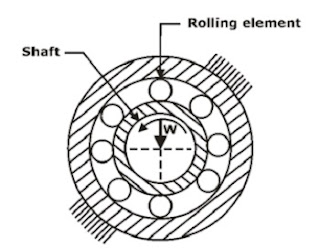A bearing is a mechanical component that reduces friction and allows relative motion between two parts, such as shaft and the housing. The function of bearing are follows.
Function of bearing
- The bearing ensures that the shaft or the axle rotates freely with minimum friction.
- The bearing supports the shaft or the axle and holds it in the proper place.
- The bearing absorbs the forces that act on the shaft or axle and transfers them to the frame or foundation.
Depending on the direction of force acting on them, bearings are categorized in several ways. Below, we can examine the many types of bearings.
Types of bearing
- Radical bearing
- Thrust bearing
Radical bearing supports the load, which is perpendicular to the axis of the shaft. While, Thrust bearing supports the load, which acts along the axis of the shaft. A Thrust bearing support the load, which at along the axis of the shaft.
Bearing are classify into two main groups: Sliding contact bearing and rolling contact bearing. Sliding contact bearing are also called plain bearing, journal bearing or sleeve bearing. Rolling contact bearing are also called antifriction bearing or simply ball bearings.
Sliding contact bearing
In this case, the surface of the shaft slides over the surface of the bush resulting in friction and wear. In order to reduce the friction, these two surface are separated by a film of lubricating oil.
Sliding contact bearing are used in the following applications
- Crankshaft bearing in petrol and diesel engines
- Centrifugal pumps
- Large size electric motors
- Steam and gas turbines
- Concrete mixers, rope conveyers and marine installations
Following are the advantages sliding contact bearing
- The shaft has simple design.
- They are less expensive.
- They are more silent in operation
- They are more compact.
- They have good shocks load capacity
- Suited for medial and high speed operation
Following are the disadvantages of sliding contact bearing
- Frictional power loss is considerable.
- They required careful attention to lubrication.
- They are normally design to carry radial load or axial load only.
Types of Sliding Contact Bearing
- Slipper Bearing
- Journal or Sleeve Bearing
- Thrust Bearing
Rolling contact bearing
Rolling element such as balls or rollers, are introduced between the surfaces that are in relative motion. In this type of bearing sliding friction is replaced by rolling friction.
Rolling contract bearing are used in the following applications
- Machine tool spindles
- Automobile front and rear axels
- Gear boxes
- Small size electric motor
- Rope sheaves crane hooks and hoisting drums
Following are the advantages of Rolling contact bearing
- Rolling contact bearing is a simple lubrications.
- These type of bearing are simple to replace.
- Overall dimension is small.
- Cleanliness.
- It is low cost of maintenance.
- These type of bearing are supported to both radial and trust loads.
- These type of bearing structure are simple to maintain and compact.
- Frictional starting torque is less than the frictional running torque.
Following are the disadvantages of Rolling contact bearing
- High initial cost
- Limited life span
- This type of bearing is lower capacity to withstand stocks
Following are the types of Rolling contact bearing
- Deep Groove ball Bearing
- Cylindrical Roller Bearing
- Angular contact Bearing
- Taper Roller Bearing
- Thrust Ball Bearing

